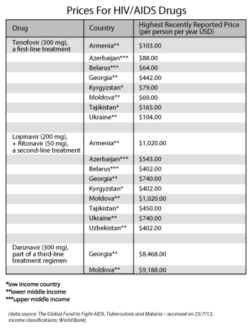WASHINGTON -- Over the past decade, hard-won victories in the fight to broaden access to basic HIV/AIDS medication have brought prices down dramatically worldwide. That's the good news.
The bad news, according to the World Health Organization, is that the number of people who require second-line medication -- used to combat the HIV virus after initial treatment stops working -- is rising fast.
Of the 34 million people infected worldwide, some half a million already require a second line of attack.
As life expectancy for HIV patients goes up, and the virus continues to mutate, third-line treatment may also be required.
Unlike the more basic drugs, however, prices for these alternate medications remain prohibitively high for many and can vary widely by country, according to a new report by the humanitarian aid organization Doctors Without Borders. The report says "patients and treatment providers are once again faced with the prospect of drugs being priced out of reach."
Complicated Cost Factors
Nathan Ford, the medical director of the Doctors Without Borders Access Campaign, unveiled the findings at the 2012 International AIDS conference in Washington, the world's largest gathering on the topic.
Complicated Cost Factors
Nathan Ford, the medical director of the Doctors Without Borders Access Campaign, unveiled the findings at the 2012 International AIDS conference in Washington, the world's largest gathering on the topic.
"The newer medicines that are needed for patients that are failing first-line therapy and second-line therapy are dramatically more expensive -- tenfold or even twentyfold more expensive than first-line treatment," Ford said. "And these aren't just drugs that are needed for a rare minority of patients."
There are multiple factors that keep costs high. Eastern Europe, where HIV infections are on the rise, provides a prime example of how the pricing system functions.
At the core of the issue is a country's patent law. If regulations are strict, or constrained by trade agreements with a pharmaceutical company's home country, the company essentially enjoys a monopoly on drug production.
Governments may override patents in the interest of public health by issuing licenses to generic manufacturers, but doing so risks igniting intellectual property disputes with the United States or European nations, where the world's largest drug companies are based.
Health Versus Commerce
With demand increasing for second- and third-line drugs, companies have fought vigorously for patents, most of which have a duration of 20 years. They are in place for these medications throughout most of Eastern Europe.
India, long considered the "pharmacy of the world" for its mass production of generic drugs, has also recently come under pressure to grant patents to drugs, which affects nations that look to Delhi for cheaper medicine.
Michelle Childs, the director of policy advocacy for the Doctors Without Borders’ Access Campaign, says that's also the case in countries like Georgia, classified as lower middle income, as well as in Russia, classified as an upper middle-income nation.
"If you're looking at a third-line regimen, which requires three drugs, just one of those drugs in Georgia is $8,000 [per person per year] -- just for one element [of the treatment]," she says. "If you're looking at Russia, if you look at the whole combination [of drugs], they're paying $27,000 [per person per year]. These countries are facing rising costs and the need to treat people.
"What we're seeing is a clash between medical needs and commercial needs," Childs adds. "What's happening is that the companies are, in effect, saying that for lower-middle-income and middle-income countries, we want the commercial needs to come first."
Generics Needed
Drug companies have argued for the importance of maintaining financial incentives to spur new research.
Some patent-holding drug companies can also determine what prices breaks they offer within a country on a case-by-case basis.
Additionally, they can arrange their own deals with generic producers, but limits on distribution are often involved. Both routes can contribute to prices varying significantly between countries in the same region -- based on determinations that usually remain private.
Additionally, they can arrange their own deals with generic producers, but limits on distribution are often involved. Both routes can contribute to prices varying significantly between countries in the same region -- based on determinations that usually remain private.
According to the report, generic competition is what's needed to bring prices down for second- and third-line drugs, just as it did for the primary medicines used to fight HIV.
"People's lives are on the line and it's up to governments and pharmaceutical companies," says Childs. "The real solution here is a political one."








